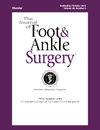The impact of minor amputation on occurrence of major amputation in patients with diabetic foot ulcers
IF 1.3
4区 医学
Q2 Medicine
引用次数: 0
Abstract
Diabetic foot ulcers (DFU) may lead to lower extremity amputation (LEA). Although minor LEAs (at or distal to the ankle) can carry a higher risk of perioperative complications compared to major LEAs (proximal to the ankle), they can increase patient independence and quality of life. This study aims to elucidate the impact of minor LEA on the time between DFU occurrence and major LEA to help determine the safer and more efficacious LEA choice for a given clinical situation. Data from 4,199 DFU patients from the TriNetX research platform were utilized. Kaplan-Meier curves and Cox regression were conducted to evaluate the impact of minor amputations on the likelihood of subsequent major amputations. Of the patients studied, 83 (23.85%) underwent minor LEAs, while 265 (76.15%) received major LEAs. DFU patients who had undergone a minor amputation were 28.1 times more likely (P < 0.001) in time-to-event analysis, 63.3 times more likely (P < 0.001) in time-varying analysis, with minor amputation as a time-varying covariate, and 60.8 times more likely (P < 0.001) in multivariate time-varying analysis to receive a major amputation than DFU patients who had not. DFU patients with minor LEAs were at higher risk for subsequent major LEAs. Clinically, these results imply that minor amputations are likely not the last step in a patient’s care and that their utilization should be improved. Shared decision-making with DFU patients should account for the potential for upfront major LEA to avoid complications of stepwise progression from DFU to minor to major LEA.
糖尿病足溃疡患者小截肢对大截肢发生的影响。
糖尿病足溃疡(DFU)可能导致下肢截肢。虽然较小的LEAs(踝关节远端或踝关节远端)比较大的LEAs(踝关节近端)有更高的围手术期并发症风险,但它们可以提高患者的独立性和生活质量。本研究旨在阐明轻微LEA对DFU发生与严重LEA之间时间的影响,以帮助确定特定临床情况下更安全有效的LEA选择。使用来自TriNetX研究平台的4199例DFU患者的数据。采用Kaplan-Meier曲线和Cox回归来评估轻微截肢对随后主要截肢可能性的影响。其中轻度LEAs 83例(23.85%),重度LEAs 265例(76.15%)。在时间-事件分析中,接受过轻微截肢的DFU患者接受大截肢的可能性是未接受小截肢的DFU患者的28.1倍(P < 0.001),在时变分析中,接受小截肢的DFU患者接受大截肢的可能性是未接受小截肢的DFU患者的63.3倍(P < 0.001),多变量时变分析中,接受小截肢的DFU患者接受大截肢的可能性是未接受小截肢的DFU患者的60.8倍(P < 0.001)。伴有轻微LEAs的DFU患者随后发生主要LEAs的风险较高。在临床上,这些结果暗示轻微截肢可能不是病人护理的最后一步,他们的利用应该得到改善。与DFU患者共同决策应考虑到前期严重LEA的可能性,以避免从DFU到轻微到严重LEA的逐步进展并发症。
本文章由计算机程序翻译,如有差异,请以英文原文为准。
求助全文
约1分钟内获得全文
求助全文
来源期刊

Journal of Foot & Ankle Surgery
ORTHOPEDICS-SURGERY
CiteScore
2.30
自引率
7.70%
发文量
234
审稿时长
29.8 weeks
期刊介绍:
The Journal of Foot & Ankle Surgery is the leading source for original, clinically-focused articles on the surgical and medical management of the foot and ankle. Each bi-monthly, peer-reviewed issue addresses relevant topics to the profession, such as: adult reconstruction of the forefoot; adult reconstruction of the hindfoot and ankle; diabetes; medicine/rheumatology; pediatrics; research; sports medicine; trauma; and tumors.
 求助内容:
求助内容: 应助结果提醒方式:
应助结果提醒方式:


